How to Screw into Concrete without a Hammer Drill (5 Steps)

It’s not mandatory to have a hammer drill to make a neat hole in a concrete surface.
You can do this easily with a masonry bit. Do not use a regular drill bit. They are not as strong and sharp as masonry bits. As an electrician and contractor, I have to regularly drill many holes into concrete on the fly and do it all without hammer drills. Most hammer drills are costly, and sometimes they may be inaccessible. So, knowing how to drill a hole without them saves you the ordeal.
Some steps to easily screw into a concrete surface without a hammer drill:
- Get a masonry drill bit
- Make a pilot hole
- Start drilling
- Pause and cool the bit in the water
- Clean out the hole by removing dust and debris
Below, I will show you how to do these steps in detail.
Getting Started
Drilling through any concrete surface without a hammer drill requires patience. Still, with the right (aforementioned) drill bits, you can do it easily.
Step 1: Get the Right Drill Bit
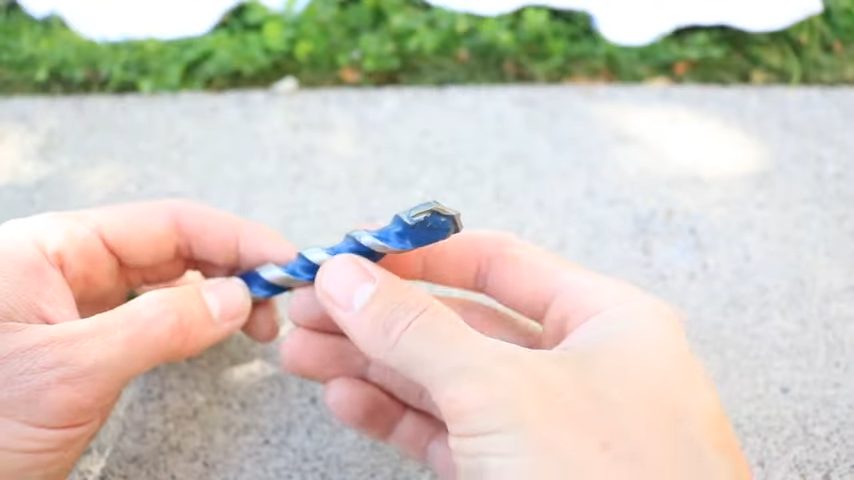
The first thing is to fetch the correct drill bit for the task. The most relevant drill bit for this task is the masonry drill bit.
Why a masonry drill bit and not just a regular drill bit?
- It has tungsten carbide tips, making it sturdy and capable of penetrating hard concrete surfaces. A regular bit doesn’t have these features and can easily break.
- Sharpness — The masonry drill bits have been designed for tough surfaces; the sharpness of the bit makes them increasingly suitable for drilling into concrete surfaces.
Step 2: Wear Safety Gear
A drill bit hurls debris as it penetrates a material. Concrete is stiff and can damage your eyes. Sometimes the sound of the drill bit is deafening or troubling.
For instance, the screeching sound as the drill bit dives into the concrete surface can affect some individuals who are reactive to it. So, to prevent such situations, wear your safety glasses and ear protection.
Do not forget to wear an appropriate face mask. Drilling concrete produces a lot of dust. Dust can cause or worsen respiratory infections.
Step 3: Make a Pilot Hole
The next thing to do is map the regions where you want to drill a hole in the concrete. You can use a pencil, a caliper, or a drill bit to zone out where you want the holes to be.
Whichever tool you use, ensure the area is marked to avoid drilling wrong sections.
Step 4: Make the Cut
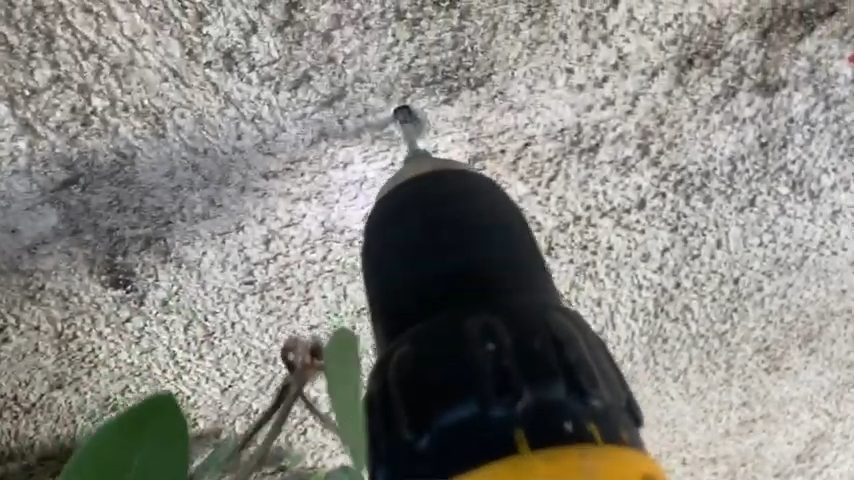
It matters how you orient or incline the drill bit while starting the cut. I recommend starting the cutting at a 45-degree angle (the best technique for drilling for larger holes). You don’t have to measure the angle; just tilt the drill bit and approximate the angle.
Once the drill bit advances into the concrete surface, gradually increase the drilling angle to 90 degrees — perpendicularly.
Step 5: Continue Drilling
As I stated before, patience is key. So, drill slowly but steadily with average pressure. Too much pressure will risk the whole cut.
To accelerate the process, attempt to ascend and descend the tool frequently. This will also help to toss out the debris from the hole, making the drilling process faster and more efficient.
Step 6: Take a Break and Cool the Bit
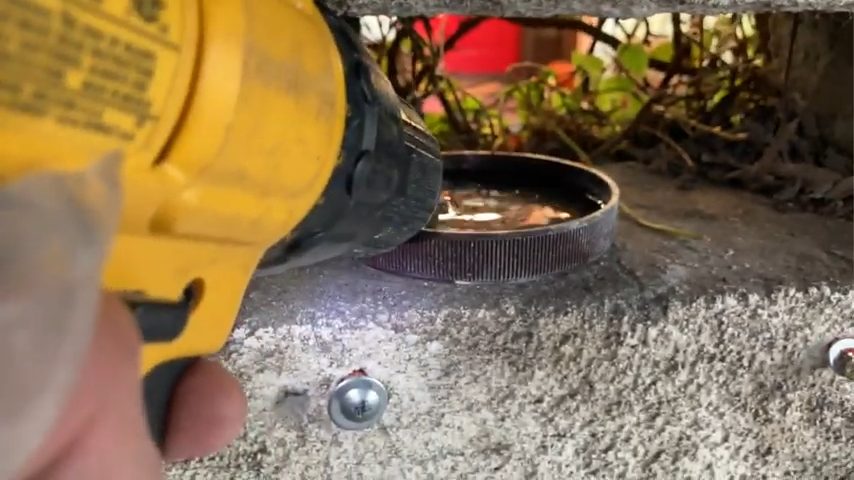
Concrete materials and surfaces are stiff. So, the friction between the drill bit and the surface generates immense heat that can damage the drill bit or even cause a fire if flammable materials or gases are nearby.
To prevent such incidents, take breaks regularly to cool things down. You can also pour cold water into the hole to accelerate the cooling process.
Dip the drill bit in the water. Pouring water on the concrete surface is a lubricant that reduces the bit’s friction, overheating, and dust problems.
Step 7: Clean and Continue Drilling
While your drill bit cools down, take a moment to clean the hole. Scrape off concrete debris with a tool. Removing the debris from the hole will facilitate the drilling process. You can use a vacuum to clean off the dust.
After cooling the bit and cleaning the hole, proceed with drilling until you reach the intended depth. Ensure you switch to large-size drill bits as you progress for larger holes.
Step 8: Stuck Drill Fix
Using a regular drill bit to drill a hole in a concrete surface is not as smooth as you may predict. The drill bit will frequently get stuck in the hole due to debris accumulation.
It is simple to undo the problem:
- Use a nail and a sled to break it loose
- Do not hit the nail too deep into the surface for easier retrieval
- Scoop out the debris or build-up
Step 9: Large Holes
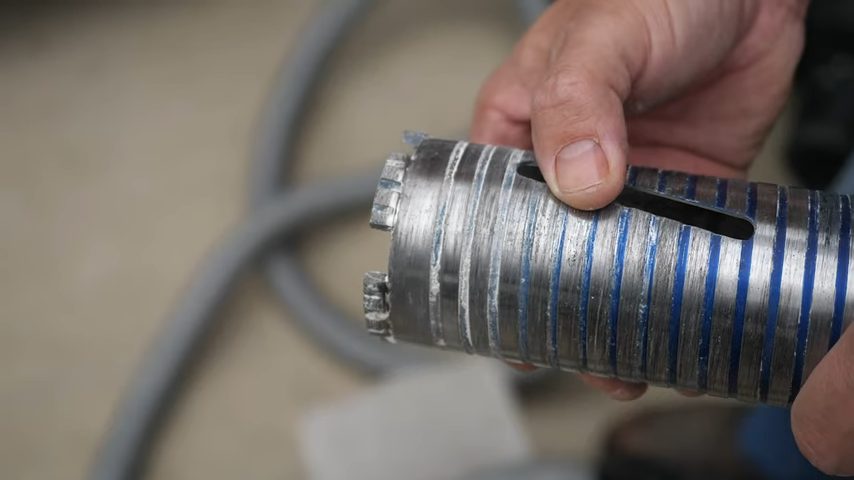
Perhaps you want to enlarge or drill large holes in concrete surfaces without a hammer drill. Here is what you should do:
- Get a core bit
- Start the cut at 45 degrees
- Then follow steps 1 through 7 strictly
For pass-through holes, use long drill bits. That way, you won’t have to remove the cut-out section in the middle of the drilling process. However, the process will be harder for older concrete surfaces.
The Best Drill Bit for Drilling Concrete
As mentioned, a proper drill bit is a must for this task. Wrong or regular drill bits can break or fail to produce good results.
Get yourself a masonry drill bit.
Masonry Drill Bits – Recommended
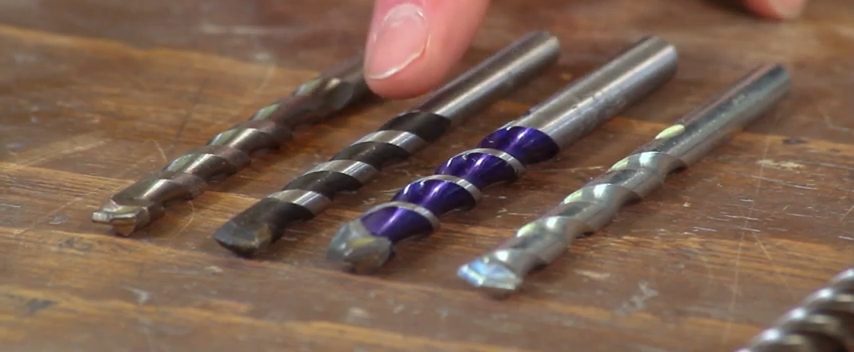
Properties:
- They have tungsten carbide-coated tips, which make them hard and unique. The hardened tip enables them to penetrate stiff surfaces without fuss. Concrete is hard and thus requires such masonry drill bits.
- Masonry drill bits are sharper and longer than regular steel and cobalt bits. Sharpness is a crucial feature. However, if you already have capable drill bits, ensure they are sharp.
- Easy to swap drill bits. You can gradually switch to large-size drill bits as you progress.
Other factors to consider when looking for the best drill bit to use to drill concrete surfaces include the following:
Shank
Select a drill bit with the correct shank.
Drill Bit Size
This is an important aspect. For big holes, start with small-size drill bits and then slowly switch to large bits.
Get a Good Brand of Masonry Drill Bits
The brand of the drill bit is also crucial here. Poor quality or cheap masonry brands will disappoint. So, get a brand with a solid reputation for the task. Otherwise, you will waste money repurchasing the bits or squander time with a poorly-performing drill bit.
A good brand will save time, money, and energy. The tool will be doing almost the entire work. (1)
How Do Masonry Drill Bits Work?
The masonry drill bits drill holes in concrete surfaces in two steps.
First Step: The tip of the masonry bit has a larger diameter than the shaft below it. So, when the shaft gets on the hole, it fits in.
Second Step: The drilling is done at a lower speed. The slow spinning of the bit reduces heat generation and overheating. (2)
Do’s and Don’ts
| Do’s | Don’ts |
| Regularly lift your drill bit out of the hole to remove dust and debris. The hammering action also reduces friction. | Do not operate at high speed when drilling. You may break the drill bit or get it stuck. Proceed patiently. |
Take a look at some of our related articles below.
References
(1) save time, money, and energy – https://www.businessinsider.com/26-ways-to-save-time-money-and-energy-every-single-day-2014-11
(2) heat generation – https://www.sciencedirect.com/topics/engineering/
heat-generation
Video References
Handyman Startup
a handywoman + her dog
Ohio Power Tool
